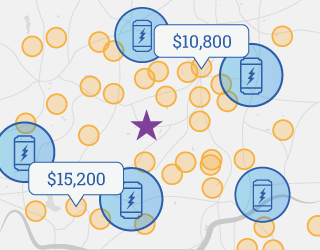Nationwide, one-in-three solar shoppers are interested in home energy storage solutions. Within the EnergySage Solar Marketplace, this percentage is even higher: nearly three-quarters of all consumers indicate they are interested in receiving solar quotes that include energy storage. To meet this demand, a few national solar installation companies have partnered with energy storage manufacturing companies to exclusively offer their batteries to solar shoppers. One such example is the partnership between Vivint Solar and LG Chem.
The Vivint + LG Chem energy storage system
Vivint announced in May 2018 that it was entering into a partnership with LG Chem to provide energy storage systems to its solar shoppers. LG Chem, the chemical and storage manufacturing arm of the widely recognized consumer brand LG, has over two decades of experience developing lithium-ion batteries for various applications, including for electric vehicles such as the Chevy Bolt.
Through the partnership, Vivint is offering LG Chem RESU batteries to their solar shoppers. The primary product available in the American market, the RESU 10H, is comparable to other batteries in terms of size, power, and pricing. The battery can integrate seamlessly with Vivint’s solar inverters and will be monitored by Vivint’s team to ensure that it is operating correctly and efficiently.
Why invest in solar + storage?
The demand for and interest in energy storage from solar shoppers across the country is primarily driven by two key factors: economics and resiliency. The economics of energy storage systems are improving nationwide. In some regions, utility electric rates are designed in a way that favors solar customers that also have energy storage systems. For instance, customers who have time-of-use rates can store their solar electricity in a home energy storage system to then use during the times of day when it’s expensive to draw electricity from the grid.
To date, though, a large portion of interest in energy storage systems is driven by resiliency. People invest in batteries to ensure that their lights and other appliances stay on even in the event of a grid emergency or an extended electrical outage. Energy storage systems can provide peace-of-mind and electric back-up in areas that experience frequent weather-related outages.
Energy storage offerings from Vivint vs. Tesla vs. SunRun
With the Vivint + LG Chem partnership, the three largest solar installation companies nationwide all now offer home energy storage solutions to their customers. While Tesla offers its proprietary Powerwall 2, both Vivint and SunRun have partnered with LG Chem for their battery product. SunRun’s offering, the Brightbox Solar Pack, uses the same battery as Vivint: the LG Chem RESU 10H. Both Vivint and SunRun take the RESU 10H battery and add an inverter and a software stack on top of them to create a home energy storage solution that is responsive to your needs.
From a technical specifications perspective, the LG Chem RESU 10H and the Tesla Powerwall 2 are similar batteries. The two batteries are nearly identical sizes and both of the batteries have the same power output (7 kilowatts of peak power). However, the total energy storage capacity of the Powerwall 2 is 43 percent higher than the RESU 10H (13.5 vs. 9.3 kilowatt-hours) and the usable energy storage capacity is 53 percent higher (13.5 vs. 8.8 kilowatt-hours).
The key difference in the battery offerings between Tesla, Vivint, and SunRun is in the purchasing and financing options that each installer offers for their battery. SunRun is only offering the Brightbox to consumers who are currently installing solar, not those with existing SunRun systems, and offers both leasing and ownership options for their energy system. Tesla sells the Powerwall 2 to new solar homeowners in addition to offering retrofit installations. It appears Vivint is offering batteries to all of their customers, both new and existing, and began with California consumers before expanding the service nationally over the course of 2018. Importantly, both the Powerwall 2 and the RESU 10H aren’t exclusive product offerings of these three major solar installation companies; solar shoppers can purchase both technologies from many smaller, local solar companies as well.
Check out your energy storage options through EnergySage
As the technology costs for batteries continue to decline and as states and utilities begin to offer very favorable incentives for energy storage systems, there’s never been a better time to go solar with storage. If you, like so many solar shoppers, are interested in learning more about installing an energy storage system in addition to solar, you can specifically request storage quotes when you register for the EnergySage Marketplace.






